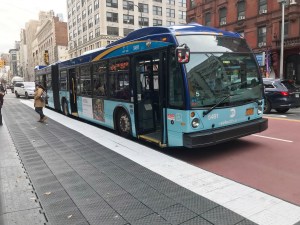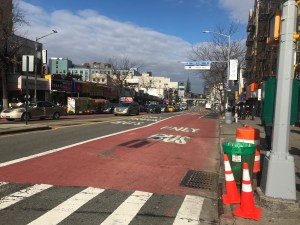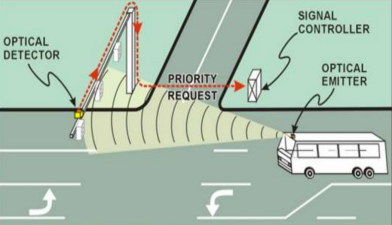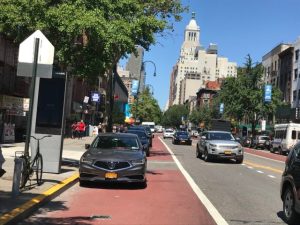Good News, Bad News: Riders Return To Buses — But Speeds Are Dropping
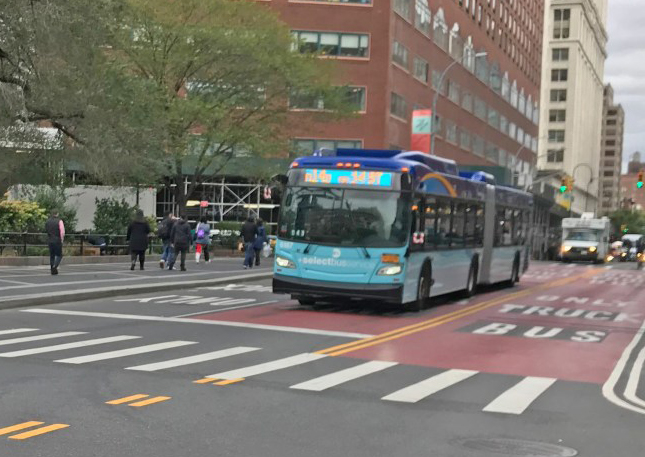
Riders are getting back on the bus, but speeds are also dropping to pre-pandemic levels because of an increase in both riders and traffic, new MTA data show.
Bus ridership hit a coronavirus-era high of about 1.2 million riders on July 9, up from a low of 430,000, but is still roughly half of normal ridership, said New York City Transit Senior Vice President Craig Cipriano.
Cipriano was less excited when discussing bus speeds, which have dropped from the recent high of a citywide average of 9.2 miles per hour, down to 8.6 miles per hour, a 6.5-percent decrease
Cipriano cited a variety of factors.
“[O]ur buses continue to navigate through multiple new obstacles to the normal flow of traffic — an ever-changing patchwork of demonstrations, the painting of street murals spelling out ‘Black Lives Matter’ in all boroughs, and the implementation of restaurant seating in curb lanes and sidewalks,” Cipriano wrote in the July Transit and Bus Committee briefing book, while also calling the protests and changes to city streets “important.”
Only six streets have been closed for the Black Lives Matter murals, and while each of them were a route for below-average bus speeds, the murals didn’t necessitate massive bus rerouting plans (and certainly diverting buses from just six blocks citywide wouldn’t skew an entire city’s average).
The MTA also noted that slower bus speeds were reflective of “increased traffic and ridership levels” from the city’s slow reopening, which seem like more likely culprits for citywide slowdowns. Manhattan buses fared the worst in the slowdown, going from 7.6 miles per hour in May down to 6.8 miles per hour in June, a 10.5-percent drop in bus speeds. Brooklyn and Queens buses also faced steep percentage declines in the same time period, going from 8.5 miles per hour to 7.7 miles per hour (down 9.4 percent) and 10.8 miles per hour to 9.8 miles per hour (down 9.2 percent), respectively.
The MTA’s bus boss was copacetic, though, when asked if the drop in bus speeds was worrying.
“A lot of work has been done behind the scenes, and we’ll continue to work with the city in regards to putting in more bus lanes,” Cipriano said on Tuesday afternoon. “We’re still working on our [Automated Bus Lane Enforcement] program and as we move ahead we’ll be working with New York City to implement all those initiatives in our bus improvement plan.”
The de Blasio administration has promised to install 3.5 miles of busways and 16.5 miles of bus lanes around the city, but that’s still less than the 60 miles that the MTA asked the city to install, and so far the only project that has been completed is a bus lane from Avenue C to First Avenue on 14th Street in Manhattan.
In addition to the thus-far unfinished bus improvements in every borough, the de Blasio administration has been dinged for taking too long to install a badly needed bus improvement in traffic lights. Transit signal priority, a technology that turns lights green or keeps them green as buses approach, has lagged because the city insists on studying each intersection, according to the Daily News.
The city aimed to install TSP at 300 more intersections in 2020, but that plan is now threatened by the $5.7-million cut to the mayor’s Better Bus Initiative for the current fiscal year, which started on July 1.
But the drop in speeds is bringing the average bus speed in the city dangerously close to the average bus speed of about 8 miles per hour that buses move during non-pandemic times. If that happens, the city will have wasted its chance to install badly needed bus improvements before car and truck traffic, which has slowly rebounded to more than half of its pre-pandemic levels outside of Manhattan as the economy has reopened, something advocates said was as predictable as a Jed Lowrie injury in 2020.
“This was unfortunately predictable, but not inevitable,” said Riders Alliance Communications Director Danny Pearlstein. “The mayor needs to ramp up bus lane installation to honor essential workers and more our streets more equitable.”
The city Department of Transportation did not respond to a request for comment.
